RBA Annual Conference – 2016 Contractions in Chinese Fertility and Savings: Long-run Domestic and Global Implications Jane Golley, Rod Tyers and Yixiao Zhou[*]
- Download 592KB
1. Introduction
Between 1978 and 2008, China's real GDP grew at an average annual rate of 10 per cent. During this period, domestic economic reforms, coupled with opening up to the international economy, helped to transform it from one of the world's poorest countries into a ‘middle-income’ country, the world's third largest economy (or second largest measured in PPP terms) and its third largest exporter (after Germany and the United States). The growth surge commenced with rural de-collectivisation and the consequent rise in agricultural productivity, which precipitated the world's largest ever rural–urban migration, enabling workers to be combined with capital and imported technology, yielding rapid productivity growth. The speed of growth, combined with lagging social institutions and industrial reform, also induced high and rising household and corporate saving rates, both of which financed extraordinarily high levels of investment. The policy framework that emerged fostered export- and investment-led growth and it not only transformed China's economy dramatically during this period, but the global economy as well.[1]
These three decades also heralded dramatic demographic change in China. A substantial increase in population – from 987 million in 1980 to 1.34 billion in 2010 – occurred despite declining rates of population growth. There were ongoing declines in fertility, commencing in the mid 1960s and accelerated by the introduction of the one-child policy in 1980, along with socio-economic developments thereafter. Crucially, the 1980s saw the beginning of rapid drops in youth dependency, and a corresponding increase in the growth of the labour force relative to that of the total population. This provided China with the much-celebrated ‘demographic dividend’, which accounted for between one-sixth and one-quarter of per capita GDP growth in this period according to some estimates.[2]
However, this period was not without its problems. On the economic front, while the first decade and a half delivered ‘reform without losers’, from the mid 1990s onwards it became increasingly clear that this had shifted to ‘reform with losers’ (Lau, Qian and Roland 2000). By the mid 2000s, growth had become highly unbalanced. China produced more than it consumed and so exported more than it imported and saved at an unusually high rate, beyond domestic investment needs, thereby accumulating considerable foreign assets. Along with a number of associated imbalances, this contributed not only to growing social unrest on the domestic front, but also created tensions abroad. Protectionist pressures rose and, in the extreme, there were accusations that China's savings ‘glut’ had been a major contributor to the global financial crisis in 2008–09 (Bernanke 2005, 2011).
Since that time, China's economic problems have reached new heights. At the National People's Congress in March 2015, Premier Li Keqiang's address was the most candidly pessimistic address in decades, acknowledging that ‘[w]ith downward pressure on China's economy building and deep-seated problems in development surfacing, the difficulties we are to encounter in the year ahead may be even more formidable than those of last year’ (Li 2015). Around the same time, Premier Li lowered the country's target rate of growth of GDP to ‘around 7 per cent’ for 2015, which has been touted as the ‘new normal’ rate of growth. The official GDP growth estimate for 2015 came in on target, at 6.9 per cent, and is still a remarkable rate of growth by international standards. However, there is growing anxiety both inside and outside of China about whether this ‘new normal’ rate of growth is either accurate (Wu 2014) or sustainable, and what the domestic and global economies will look like in China's ‘post-boom’ period.
On the demographic front, while the one-child policy has always been controversial abroad, the economic benefits of the rapid decline in fertility received much attention in the past, not least by Chinese leaders themselves. In recent years, however, attention has shifted to the negative and longer-term consequences of that decline. The most obvious of these is the relatively rapid ageing of the Chinese population, with aged dependency projected to more than double between 2010 and 2030, and nearly double again by 2050 (United Nations 2015). This, according to most analysts, will bring China's demographic dividend to a rather sudden end, placing it in the unique position of being a transitional, developing economy facing what is primarily a developed country phenomenon, or ‘growing old before growing rich’ (Cai 2010, 2012). Rising gender imbalances, and their contribution to rising household savings, have also become a focus of economic research, with some scholars going as far as to suggest that ‘[w]hile the sex ratio imbalance is not the sole reason for global current account imbalances in recent years, it could be one of the significant, and yet thus far unrecognized, factors’ (Du and Wei 2010, p 2).
The Chinese Government has not stood idly by as these complex and interconnected, economic and demographic pressures have escalated. In 2004, the Chinese Government under President Hu Jintao began to emphasise the need for a more balanced growth strategy that would simultaneously alleviate rising income inequality within China, reduce the pressure on energy demand and the environment, promote employment growth and reduce the country's reliance on external demand (Lardy 2006; Hu et al 2008; Wang and Cai 2015). Although only limited ‘rebalancing’ has occurred in the decade since, Xi Jinping remains committed to a reform agenda that should, if effective, lead the economy towards consumer-led growth in the decades ahead. A likely outcome of these reforms – and indeed a necessary one for rebalancing to succeed – is lower national saving rates in the future.
A more definitive decision came in late 2015 with the announcement that the one-child policy would be abolished and replaced with a nationwide two-child policy, effective as of 1 January 2016. The dominant reason for this change, as stressed in Chinese media reports, was that relaxing family planning policy would provide part of the solution to the ageing problem, with higher fertility expected to produce more than 30 million additional people in the labour force by 2050. The National Health and Family Planning Commission of the PRC also reported that a two-child policy could increase the rate of economic growth by 0.5 percentage points via its effect on aged dependency (e.g. Wang 2015). These calculations hinged on the assumption that a significant number of the fertile population will respond by actually having a second child – an assumption that is highly uncertain according to much demographic research on the topic. These studies suggest an alternative future in which China falls into a ‘low-fertility trap’, consistent with other countries in the region, including Japan and South Korea (Chen et al 2009; Basten and Jiang 2015; Zhao 2015).
As 2016 commences, the economic and demographic strategies being pursued by the Chinese Government are indicative of at least two interrelated conundrums that do not appear to have been given adequate attention by either the policymaking or academic communities. The first is that rebalancing the economy towards domestic consumption will require a reduction in the high saving rates that provided a key source of finance for the investment-led growth of the past. It is far from clear that this reduction will actually occur and hence whether consumption will sustainably replace export demand, allowing growth to continue at the intended pace (Ma and Wang 2010; Yang, Zhang and Zhou 2011). The second is that, while higher fertility rates would indeed contribute to higher rates of GDP growth and likely to higher consumption as well, higher fertility would come at a per capita income cost, with negative welfare implications (in economic terms at least) for the average Chinese citizen – just as lower fertility brought about a demographic dividend in per capita income in the past. On this point, the Chinese leadership appears to be largely silent.
This paper assesses the seriousness of these conundrums using a dynamic global economic model that incorporates full demographic behaviour. This enables us to clarify how alternative trajectories for China's fertility and saving rates will affect China's economic performance through to 2050 and, in turn, what these alternative trajectories will mean for economic performance in the rest of the world. We begin with a baseline scenario for the global economy through to 2050, in which continued high GDP growth is achieved through both the rising fertility that a two-child policy could potentially bring and an overall saving rate that declines only modestly. We then compare this with three alternative scenarios: a low-fertility scenario in which fertility is assumed to decline along its present path; a low-saving scenario in which Chinese savings are assumed to decline relatively rapidly toward levels common in the industrialised West; and a combination of these two – a ‘double contraction’. Our reason for this experimental structure is to emphasise the domestic and international implications of two potentially significant sources of a slowdown in Chinese growth in the decades ahead. The results offer numerical foundation to the anxieties relating to China's ‘post-boom’ period and they show that the implications for the rest of the global economy could be considerable.
The paper proceeds as follows. Section 2 sets the scene with a discussion of some of the theoretical and practical links between demographic change, savings and economic growth in China's context. Section 3 summarises our approach to modelling demographic change and economic performance in a global context. Section 4 presents the baseline and counterfactual scenarios, and their projected outcomes for GDP growth in the Chinese and global economies through to 2050. We then delve deeper into the channels through which lower fertility and savings impact on economic performance in China (Section 5) and the rest of the world (Section 6). Conclusions are offered in Section 7.
2. The Context
2.1 Demographic change and economic growth
China's demographic transition commenced well before the one-child policy was introduced in 1980, with fertility rates declining from the 1950s onwards. There were particularly sharp drops in the 1970s, coinciding with the introduction of the ‘later, longer, fewer’ policy – in this decade alone, the total fertility rate was halved, from 5.8 in 1970 to 2.7 in 1979 (Feng and Cai 2010). The one-child policy solidified this decline and, according to official claims, averted 400 million births during its first three decades. More careful analysis by demographers indicates that this figure is a substantial overestimate, attributing many of the averted births instead to the socio-economic changes accompanying rapid economic growth during this time – including urbanisation and new employment opportunities for rural migrants, improvements in female education and the high parental cost of supporting children through an increasingly competitive education system (Feng, Cai and Gu 2012). Regardless, there is no question that China's population growth has slowed substantially since 1980 and that the one-child policy was a contributing factor to this slowdown.
The most direct economic effect of declining fertility, and hence slower population growth, is slower GDP growth but higher per capita income. This result is common to all models with diminishing returns to capital and labour, including the elemental model of Solow (1956) and Swan (1956).[3] Chinese policymakers in the past appeared to accept this premise, with demographic goals set in February 1980 including a targeted population of 1.2 billion in 2000 and a population growth rate of zero by that time, specifically intended to support Deng Xiaoping's overall goal of quadrupling China's per capita income between 1980 and 2000 (Feng et al 2012). While these demographic targets were not quite met, the per capita income goal was well and truly surpassed and China's present leaders readily credit the one-child policy as being an important contributing factor. On the per capita income costs of the recent reversion to a two-child policy (which we attempt to quantify below) they are, unsurprisingly, less vocal.
A second economic effect of declining fertility, not accounted for in the Solow-Swan model, comes via the change in the age distribution of the population, which alters average labour force participation rates and youth and aged dependency ratios. At first, declining fertility reduces youth dependency and raises the proportion of workers in the population. Income per capita is therefore boosted, strengthening the basic Solow-Swan result and giving rise to the demographic dividend.[4] In most related research the proportions of dependents and workers in the population are proxied by simple age classifications: ‘youth’ below the age of 15; ‘working age’ between 15 and 65; and ‘aged’ over 65. Between 1980 and 2010 in China, there was a rapid decline in the total dependency ratio, underpinned by declining youth dependency (Figure 1).
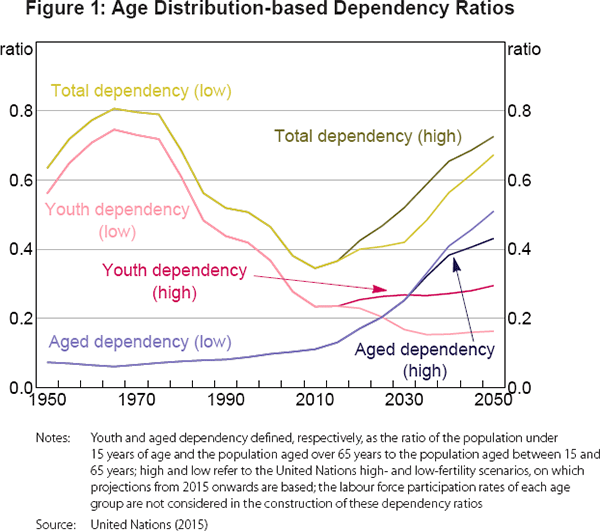
From 2010 onwards, there is a sharp upturn in total dependency driven by sharply rising aged dependency. Projections based on the United Nations high- and low-fertility scenarios further illustrate that the higher fertility that might be derived from the two-child policy has only a minimal effect on reducing aged dependency by 2050. Indeed, this is more than offset by higher youth dependency, ensuring that total dependency is higher, not lower, under the high-fertility scenario.
This paper builds on the work of Golley and Tyers (2012a, 2012b), who argue that the use of age-based proxies for understanding the links between demographic change and economic growth in China (and indeed elsewhere) is misleading, because they fail to take into account the number of actual workers in the population – as opposed to those of working age. Their more-carefully calculated dependency ratios – described and used in the modelling exercise below – provide at least one piece of good news for China: in contrast with the alarming trend shown in Figure 1, more accurately measured total dependency may fall well into the future, under both high and low fertility assumptions.
Beyond age structure, a slowdown in population growth has implications for the skill composition of the labour force. This, in turn, affects the marginal product of capital and hence the level of investment, as well as relative prices and competitiveness in different sectors of the economy. In China, this skill composition is predominantly shaped by the proportions of the rural (low-skill) and urban (high-skill) populations. In the first three decades of reform, despite the relaxation of the one-child policy in most rural areas to allow a second child if the first was female, the rural population experienced more rapid fertility decline from higher initial levels. This ensured that the bulk of China's demographic dividend stemmed from a surge in the rural working to non-working population ratio (Golley and Wei 2013). This, combined with agricultural reforms and the opening of the economy, gave rise to mass rural-to-urban migration, fuelling the rapid expansion of unskilled labour-intensive manufacturing that dominated China's export-led growth. From the mid 2000s onwards, however, slowing rural labour force growth fed into labour shortages in the major export-producing cities of the past, prompting much debate on the timing and consequences of China reaching the Lewisian turning point (Lewis 1954; Cai 2010; Minami and Ma 2010; Golley and Meng 2011). Future fertility trends, particularly as they differ between the skilled and unskilled populations, will continue to shape this debate, with implications for China's competitiveness in all sectors. Our modelling exercise below allows for these fertility distinctions.
Although the dominant economic effects of fertility declines are the slowdown in labour force growth and the change in overall dependency associated with ageing, ageing also tends to reduce national average saving rates. This effect is formalised in Modigliani's (1966) life-cycle hypothesis (LCH), which predicts an inverted U-shaped saving-age profile, in which a rising proportion of workers, particularly middle-aged, in the population will underpin rising saving rates, in contrast with rising shares of youth and young workers or the aged, all of whom tend to be dis-savers. While evidence supporting the applicability of the LCH to China has been mixed in the past, the expectation among most observers is that rapid ageing will contribute to lower aggregate household savings in the future.[5]
Recent work by Choukhamane, Coeurdacier and Jin (2014) complicates the picture further, by introducing various micro-channels through which fertility decline affects individual household saving decisions. They show that an exogenous fertility decline reduces total expenditure on children and hence raises household savings, despite the rise in educational investments for the only child. Compounding this, the ‘expenditure channel’ is a ‘transfer channel’ through which parents save more in anticipation of reduced transfers from their child in the future, despite the higher wages that child earns resulting from human capital accumulation. In all, they attribute 60 per cent of the 20 percentage point rise in China's aggregate household saving rate between 1982 and 2009 to the one-child policy, while their two-child policy experiment indicates that the rise in China's aggregate household savings would have been reduced by 6.5 percentage points.
Given these factors and compounding the LCH impact of ageing, the results from Choukhamane et al (2014) suggest that higher fertility rates – or in other words, two-child policy ‘success’ – will lead to a reduction in the household saving rate. Although operating through a different channel, this is consistent with Du and Wei (2010, 2012), who attribute close to 60 per cent of the rise in household savings in recent decades to rising gender imbalances, themselves a consequence of the one-child policy, among other factors (Golley and Tyers 2014). Their argument rests on the assumption of a ‘competitive marriage market’, in which single men (and their parents) save more in order to compete via wealth accumulation in the face of some 30 million ‘excess men’ of marrying age. The two-child policy is likely to reduce some of this pressure, albeit with a considerable lag, and this channel therefore offers a further possible reason for lower household savings in the future.
2.2 Savings, rebalancing and growth
Another reason why China's saving rates are expected to decline in the future is the government's ‘rebalancing’ strategy, focused in particular on reducing China's reliance on exports and investment and instead targeting consumption-led growth. While this strategy met with little success under Hu Jintao, Xi Jinping has already demonstrated greater commitment to reforming an economy that had, in the words of Hu's Premier Wen Jiabao, become ‘unbalanced, uncoordinated and unsustainable’ (Xinhua News Agency 2007). Xi formally announced his reform agenda at the Third Plenum of the 18th Central Committee of the Communist Party of China in November 2013 and, despite still further criticism for its slow pace, there is undeniable progress in major areas of the economy that are likely to underpin rebalancing in the decades ahead. Prominent among these are reforms to agricultural land property rights, inter-governmental fiscal reforms and steps toward addressing high corporate savings in the form of an increase in the share of state-owned enterprise dividends to be transmitted back to the state in order to support the pension and other social welfare systems (Naughton 2014; Orlik et al 2014).
The collective effect of these and other reforms will vary across the different sources of savings – households, governments and the corporate sector – and across different age cohorts, creating much uncertainty regarding future trends in China's national saving rate. Yet it is highly likely that the declining trend in saving rates since 2010 will continue, with the further expectation that this will be matched by the rising share of consumption as a share of GDP (Figure 2).[6] In recognition of this uncertainty, rather than making concrete predictions about these future trends, we investigate alternative scenarios for changes in age-specific household saving rates.
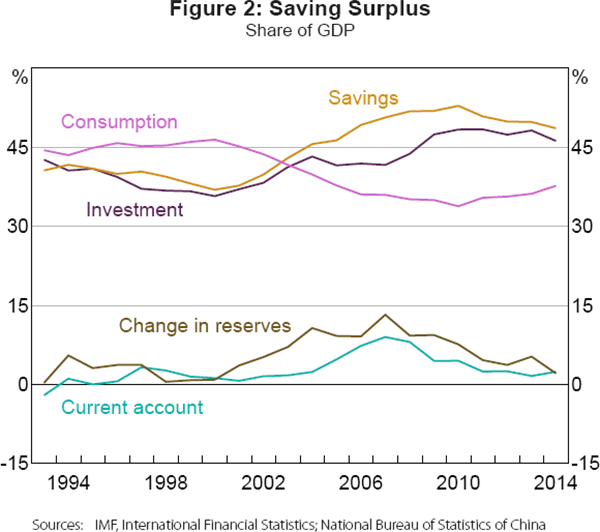
While high saving rates have underwritten the key economic imbalance, they have also provided a key source of finance for the high and sustained rates of domestic investment that, along with rapid export growth, has been the dominant driver of Chinese growth in the last three decades. Furthermore, the excess of Chinese savings over investment contributed a third of the rise in global savings since 1990 (World Bank 2013). While much attention has been given to the associated problems that this created across the globe – and particularly in the United States – in most cases, such assessments have been shown to be inaccurate or, at least, oversimplifications.[7] Indeed, as discussed in detail in Tyers (2015), the bulk of the literature addressing this issue quantitatively finds improvements in terms of both product and financial terms of trade (cheaper light manufactures and cheaper debt) that were large enough to yield net improvements in the real per capita incomes of the advanced regions. The key question that remains is whether lower Chinese savings in the future will eliminate, or at least reduce, the perceived domestic and international problems associated with higher saving, and at what cost? To answer this question, we rely on the global economic model introduced below, which is designed to address the interactions between demographic change, saving decline and economic growth touched upon here.
3. Modelling the Long-run Impacts of Chinese Demographic Change
The approach adopted follows Golley and Tyers (2012a, 2012b), in that it applies a complete demographic sub-model that is integrated within a dynamic numerical model of the global economy. The economic model is a development of GTAP-Dynamic, the standard version of which has single households in each region and therefore no demographic structure.[8] The version used here has multiple regional households, disaggregated by age group, gender and skill level, each with endogenous saving rates. Complete written details of the model's formulation and calibration are available from the authors on request.
3.1 Demography
Populations are tracked in four age groups, two genders and two skill groups: a total of 16 population groups in each of 18 regions. The four age groups are the dependent young, adults of fertile and working age, older working adults and the mostly retired over-60s. The skill division of the population separates households according to their provision of production (low-skill) labour and professional (high-skill) labour, based on the International Labour Organization's (ILO) occupational classification (Liu et al 1998).
Each age-gender-skill group is a homogeneous sub-population with group-specific characterisitics: birth rates; sex ratios at birth; age and gender-specific death rates; immigration and emigration rates; and life expectancies at 60. Differences in birth rates by skill level in China and other developing countries are intended to reflect the more readily measured rural–urban dichotomy. The sex ratio at birth is of more importance in the case of China. This is not experimented with here but is assumed to remain high, at 1.17 males per female throughout all scenarios, consistent with the starting point for the baseline scenario of Golley and Tyers (2014). Complete matrices of migration flows between regions are also represented for each age, gender and skill group, the origins of which are described by Tyers and Bain (2015). Immigration rates have base levels that depend on changes in group populations in destination countries but they are also responsive to inter-regional real wage comparisons, constrained by an elasticity parameter designed to represent the ‘gatekeeping’ roles of immigration policies in destination countries.[9] A further key parameter is the rate at which each region's education and social development structure transforms low-skill worker families into high-skill worker families. Each year a group-specific proportion of the population in each low-skill worker age-gender group is transferred to high-skill status. These proportions depend positively on the regions' levels of development (proxied by per capita income), the proportion of low-skilled to high-skilled labour and the skilled wage premium.
3.1.1 Labour force projections
To evaluate the number of ‘full-time equivalent’ workers we first construct labour force participation rates, by gender and age group for each region from ILO statistics on the ‘economically-active population’. For each age group, a, gender group, g, and region, r, a target country is identified whose participation rate is approached asymptotically. The rate of this approach is determined by the initial rate of change. Target rates are chosen from countries considered ‘advanced’ in terms of trends in participation rates. We then investigate the proportion of participating workers that are part-time and the hours they work relative to each regional standard for full-time work. The result is the number of full-time equivalents per worker and the full-time equivalent labour force, disaggregated by age, gender and skill level.
3.1.2 Dependency ratios
We define and calculate four dependency ratios: 1) a youth dependency ratio is the number of children per full-time equivalent worker; 2) an aged dependency ratio is the number of persons over 60 per full-time equivalent worker; 3) a non-working aged dependency ratio is the number of non-working persons over 60 per full-time equivalent worker; and 4) a more general dependency ratio is defined as the number of non-working persons (including children) per full-time equivalent worker. As an indicator of how these are formulated, the following is the non-working aged dependency ratio, which is of wide policy interest:
where  is the
population in age group a, gender group g, skill group s and region r,
is the
population in age group a, gender group g, skill group s and region r,  is the labour
force in a, g, s and r, and
is the labour
force in a, g, s and r, and  is the aggregate labour
force in r.
is the aggregate labour
force in r.
3.2 The global economic model
We use a multi-region, multi-product dynamic simulation model of the world economy following the tradition of Dixon and Rimmer (2002). In it the world is subdivided into 18 regions, including, as separate regions, mainland China, Hong Kong and Taiwan. Industries are aggregated into seven sectors: agriculture, light manufacturing, heavy manufacturing, metals, energy, minerals and services. To reflect composition differences between regions, these products are differentiated by region of origin, meaning that the products supplied in one region are not the same as those in the corresponding category produced in others. Consumers substitute imperfectly between versions of such products supplied from different regions. This structure has numerous benefits, including that it allows the representation of intra-industry trade.
3.2.1 Sources of growth
As in most other dynamic models of the global economy, the main endogenous component of simulated economic growth is physical capital accumulation. Human capital accumulation occurs as well, via the skill transformation process built into the demography, but it tends to have smaller growth effects in this model.[10] Exogenous sources of growth enter the model as factor productivity growth shocks, applied separately for each of the model's five factors of production (land, physical capital, natural resources, unskilled and skilled labour) in each of the seven sectors. Simulated growth rates are very sensitive to productivity growth rates because the larger these are for a particular region, the larger is that region's marginal product of capital. The region therefore attracts higher shares of global investment and hence a double boost to its real per capita income growth rate. The factor productivity growth rates assumed here are based on an early survey.[11]
A consequence of the dominance of physical capital accumulation in the growth process is that, at least for the world as a whole, an increase in the growth rate of the population raises the growth rate of real GDP but reduces the level of real per capita income – that is, the basic Solow-Swan effect.
3.2.2 Investment
What distinguishes the model from its simpler progenitor is its recursive multi-regional dynamics. Investors have adaptive expectations about the real net rates of return on installed capital in each region. Capital accounts are open so these drive the distribution of investment across regions. In each, the level of investment is determined by a comparison of net rates of return with borrowing rates yielded by a global trust to which a portion of each region's savings contributes. The standard global model takes no explicit account of financial market maturity or investment risk and so tends to allocate investment to regions that have high marginal products of physical capital, driven by rapid labour supply growth. These tend to be labour-abundant developing countries where we know that considerations of financial market segmentation, financial depth and risk limit the flow of foreign investment at present and that these are likely to remain important in the future. To account for this we have constructed a ‘pre-baseline’ simulation in which we maintain the relative growth rates of investment across regions. In this simulation, global investment rises and falls, but its allocation between regions is controlled. To do this an interest premium variable is initially made endogenous. This creates wedges between the international and regional borrowing rates. They show high interest premia for the populous developing regions of Indonesia, India, other south Asia, South America and Sub-Saharan Africa. Premia tend to fall over time in other regions where labour forces are falling or growing more slowly. Once calculated in this way, the time paths of all interest premia are set as exogenous and regional investment is freed up in all regions. Investment is then retained as endogenous in the model's closure in all subsequent simulations.
3.2.3 Consumption and saving
The 16 groups (based on age, gender and skill) differ in their consumption preferences, saving rates and their labour supply behaviour. National income is first divided between government consumption and total private disposable income for each region. The implicit assumption, stemming from the design of the original model to serve long-run analysis, is that governments balance their budgets while private groups save or borrow.
In splitting each region's private disposable income between the eight age-gender groups, the approach is to construct a weighted subdivision that draws on empirical studies of the distribution of disposable income between age-gender groups for ‘typical’ advanced and developing countries. Individuals in each age-gender group then split their disposable incomes between consumption and saving. A reduced form approach is taken to the intertemporal optimisation problem faced by each. It employs an exponential consumption equation that links group real per capita consumption expenditure to real per capita disposable income and the real rate of return on the assets of the collective regional household. This equation is calibrated for each group and region based on a set of initial age-specific saving rates from real per capita disposable income. A mechanism is then added to allow these group-specific saving rates to trend toward long-run targets.
4. Constructing Scenarios
When numerical models are used to analyse shocks, a baseline projection is required as a starting point. This projection is not a forecast, since there are many possible shocks that determine the paths of economies through time, most of which prove to be unanticipated. In modelling exercises such as this, baselines are normally chosen to reflect the outcomes perceived as most likely by the modellers. We deviate from standard practice here by instead choosing a baseline in which fertility rates are projected to remain relatively high, and indeed rise through time, sufficiently to stabilise China's population in the long run. Similarly, our baseline savings are chosen to remain relatively high, declining over time but at a slower rate than in an alternative lower saving scenario. As noted in the introduction, our motivation for this is to emphasise the implications of a growth slowdown in China, underpinned by a demographic contraction and saving rate declines that stem from welfare and industrial policy reforms and ageing.[12]
4.1 The demographic scenarios
Baseline fertility is designed to return China's average fertility rate to a stabilising level (2.1 children per woman) by 2050, underpinned by fertility increases for both high-skill and low-skill women. This is consistent with the high-fertility scenario of the United Nations (2015), which sets China's total fertility rate at 2.13 for 2045–50. In an alternative (and, we believe, more likely) scenario, China's fertility rates are assumed to fall asymptotically toward one child per woman, similar to the rates observed in Japan and other neighbouring countries and consistent with the low-fertility trap. The fertility rate for low-skill Chinese women is projected to fall more substantially than for high-skill women, following the observed pattern in neighbouring regions (Figure 3). The average falls to a level just above one child per woman, which is in the vicinity of the UN ‘low’ demographic projection for 2045–50.
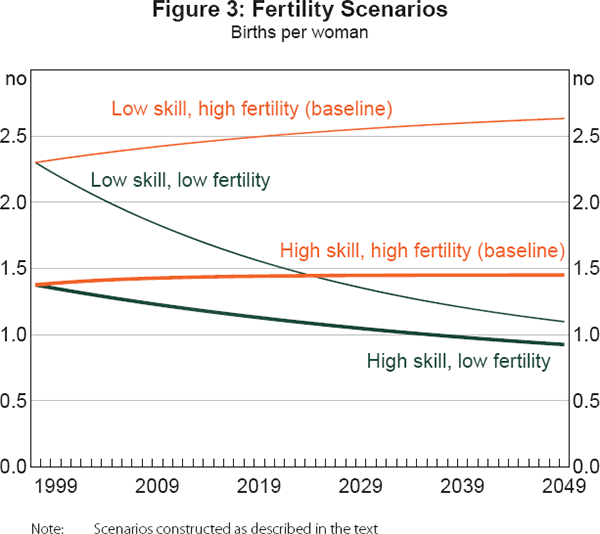
China's population and labour force differ substantially under the two scenarios, with the high-fertility scenario ensuring that both continue to rise through to 2050, while under the low-fertility scenario these both decline in the coming decade (Figure 4). Note that fertility is modelled as declining in all other regions as well, consistent with the World Bank Group (2016). Population growth remains vigorous in south Asia, Africa and the Middle East because their most populous age groups are very young and, as these groups age, they raise the labour force participation rate and the total fertility rate. Thus, in a period during which China's labour force shows little net growth, that of India, for example, rises by half. Compared with the rest of the developing world, the low-fertility scenario for China must be expected to constrain its labour supply and hence retard its overall economic expansion.
The effect of these two fertility scenarios on the age structure of the population is illustrated in Figure 5. The baseline restoration of higher fertility stabilises the populations of children and young adults, while the initial age structure of the overall population ensures that the numbers of older working-aged and retirees continue to rise. By comparison, the low-fertility scenario sees an accelerating decline in the numbers of children and young adults. Interestingly, the numbers of older workers and retirees do not rise to the heights achieved in the baseline because smaller populations in the younger age groups cause lower survival rates into these older age groups, which become influential after 2020.
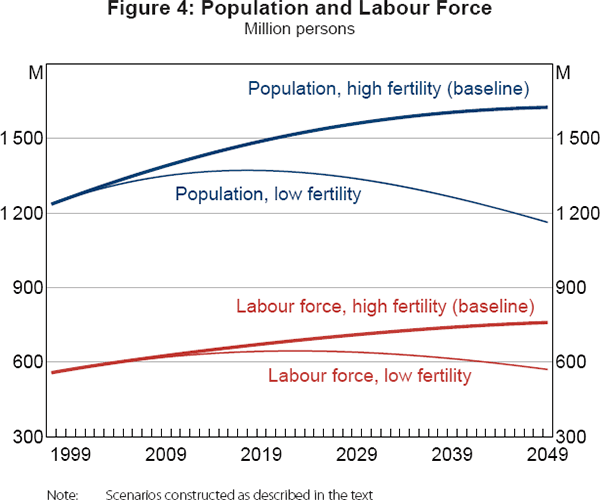
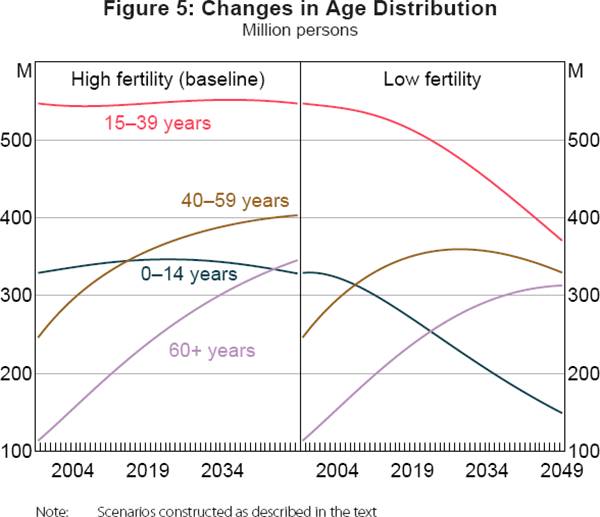
Associated with these changes in the age structure are dependency ratios. Recall that these are non-working dependency ratios and so they account for the different labour force participation rates across groups and, hence, dependents include not only children and retirees but also non-working adults of working age (Figure 6). In both scenarios youth dependency continues to fall through to 2050, most strikingly in the low-fertility scenario. The ageing built in to the initial age distribution continues to push up aged non-working dependency, in both the high- and low-fertility scenarios. While these youth and aged dependency trends are in the same direction as the United Nations' projections, our more precise definitions of dependency have crucial implications. In particular, while the United Nations' total dependency ratio starts to rise in 2010 (as seen in Figure 1), our projections result in declining total dependency all the way through to 2050. According to these projections, ageing may not be as catastrophic as many claim it to be, and the end of China's demographic dividend era may still be a long way off.[13]
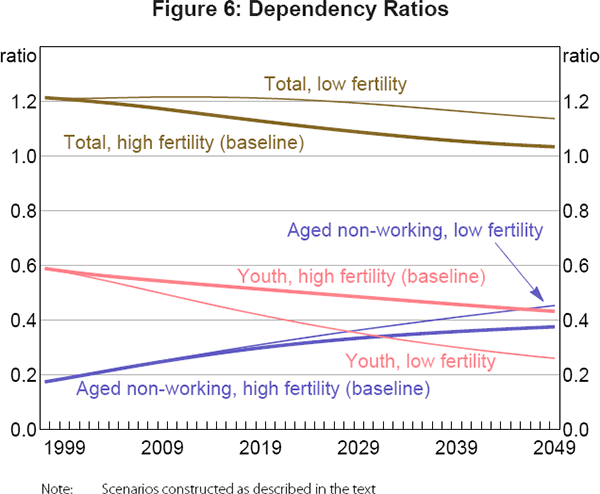
4.2 The saving rate scenarios
Based on the earlier discussion, we offer two Chinese saving rate scenarios (Figure 7). The baseline assumes high saving, in which the rate of decline in group level saving rates is slow enough that China's overall rate does not fall to advanced country levels until it achieves real per capita income parity, well beyond 2050. Note that, because age-specific saving rates differ, the average national rate from GNP applies only to the baseline assumption of high fertility. The average level actually depends on changes in the age distribution indicated. Against these high saving cases we compare a low-saving scenario in which age-specific rates of saving decline quite rapidly, particularly for retirees (60+), so that the rising population of the aged by 2050 is dis-saving at rates similar to those observed in advanced regions. In both cases, these changes in age-specific rates are constructed by specifying long-run exponential declines toward specified targets, while allowing for short-run intertemporal change in response to real per capita income and real interest rate shocks.

4.3 Projected overall performance
Besides the high-fertility baseline scenario, three projections are made to 2050 (Table 1). In the following section we discuss the implications of these deviations from the baseline for China. We note that the low-saving scenario is consistent with ‘dual policy success’: fertility is assumed to remain high in response to the two-child policy, while rebalancing policies bring the average saving rate down. In the discussion on the international implications (in Section 6) we concentrate on the low-fertility and double contraction scenarios, to emphasise what is of most concern worldwide: a slowdown of China's GDP growth in the future, brought about by one or both of these contractionary forces.
| Fertility | |||
|---|---|---|---|
| Low | High | ||
| Savings | Low | Double contraction | Low savings |
| High | Low fertility | Baseline | |
The future growth of all the modelled economies depends on three endogenous behaviours – labour force growth, capital accumulation and skill transformation – and on two sets of exogenous projections – productivity growth and investor security (interest premia). Capital accumulation depends on saving rates and each region's comparative performance in attracting investment from abroad. To a lesser extent, demographic change also depends on comparative performance, through its effects on migration incentives. The underlying productivity projections remain crucial, however, in driving regional growth and accumulation relative to other regions. A consequence of this is that the fertility and saving contractions have comparatively small (but always negative) effects on the growth rate of China's real GDP. This can be seen from the simulated paths of this growth rate (Figure 8). Importantly, the baseline shows stable growth from the present through 2050, which helps maintain the focus of the analysis on demographic and saving rate shocks.
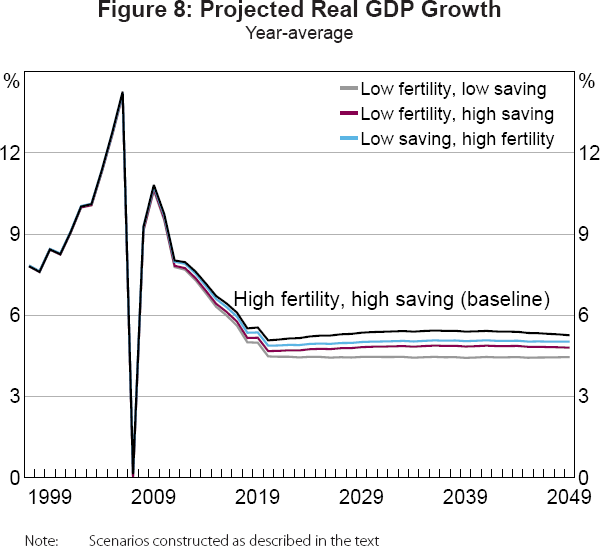
5. The Domestic Effects of More Rapid Declines in Fertility and Saving
Here, we discuss the domestic effects of rapid declines in fertility and saving in terms of the labour force, real wages and real per capita income changes, the implications for rebalancing and the changes in sectoral composition. While the real GDP growth rate deviations appear modest, they yield large departures from the baseline in the levels of real GDP and real GNP by 2050 (Figure 9). The shortfall in real GNP is comparatively large in the low-saving case because this scenario has greater foreign investment and therefore greater repatriation of capital income. The contraction scenarios have significant implications for the global economy as well: relative to the baseline, world GDP in 2050 is 3 per cent lower with a Chinese demographic contraction, 6 per cent lower with more rapid savings decline and 9 per cent lower for a double contraction.
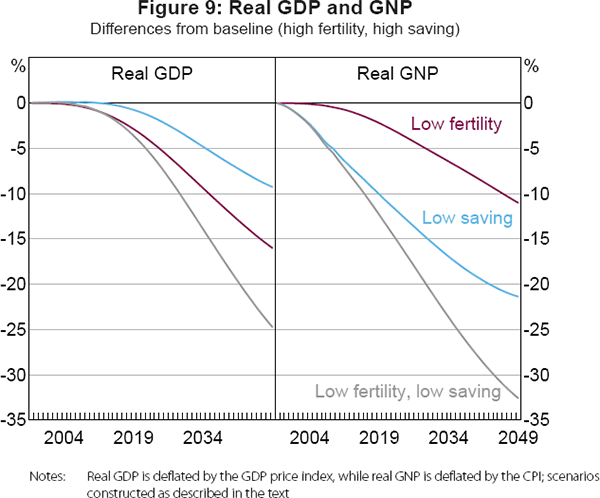
5.1 Labour force, real wage and real per capita income changes
Other things equal, it is obvious that lower fertility should increase real wage growth, due to a reduction in the relative abundance of labour. As simulated, this is particularly pronounced for low-skill labour, because the proportional fertility decline is larger for the low-skill population (Figure 10). This causes real per capita income to grow more rapidly, with the level 20 per cent higher than the baseline by 2050 (Figure 11). This confirms that the average Chinese derives economic benefits from lower fertility, in contrast to the projected GDP growth reduction that it brings.
Lower saving also negatively affects projected GDP growth rates, primarily through its effect on Chinese investment. Its effect on real wages is complicated in the short term by historical capital market dynamics, but for low-skill workers (by far the dominant proportion of the workforce) the overall effect is negative, with real per capita income 15 per cent lower compared with the baseline by 2050. In contrast, slower capital accumulation boosts the value-added share of services, which favours high-skill workers, whose real wage is slightly higher than the baseline through to around 2025.
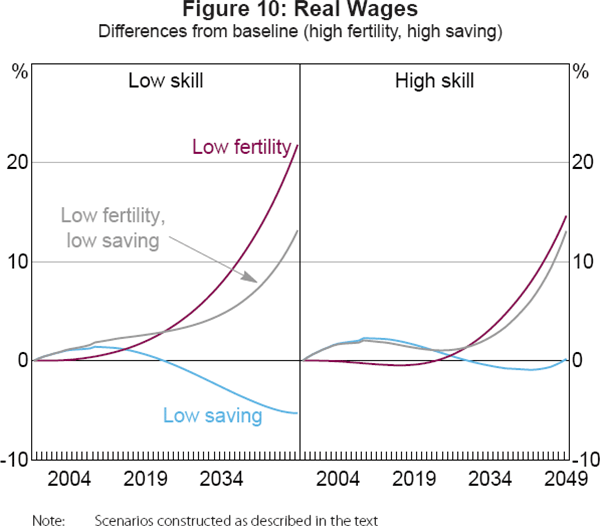
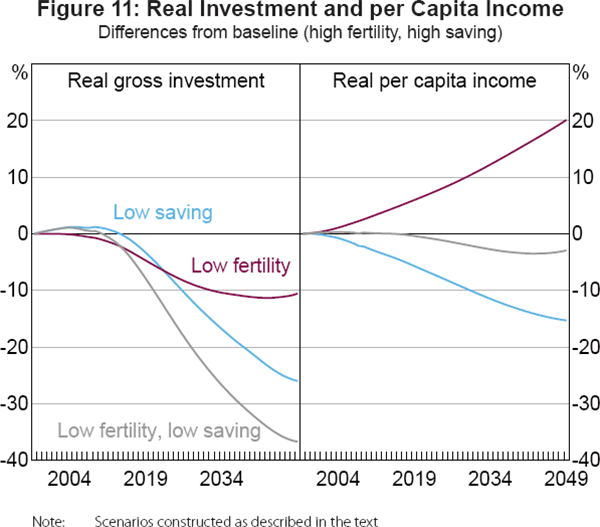
A further implication of low fertility is a reduction in the skilled wage premium in the first two decades, stemming from the relatively rapid fertility decline for low-skill females and the relatively large contraction of the low-skill labour force as a consequence. While a lower skilled wage premium slows the transformation rate from low-skill to high-skill labour, the effect is outweighed by the higher real per capita income that lower fertility brings (Figure 12, left-hand panel).
By contrast, the low-saving scenario sees a rise in the skill-wage premium relative to the baseline, particularly after 2030. The transformation of low-skill into high-skill workers is accelerated by this. But, again, the effect is more than offset by lower real per capita income, so the net effect is a decline in the skill share of the labour force. Thus, if we think of the high-fertility, low-saving scenario as the case of ‘dual policy success’, the results highlight a contradiction: success leads to lower real per capita income and a lower skilled labour force.
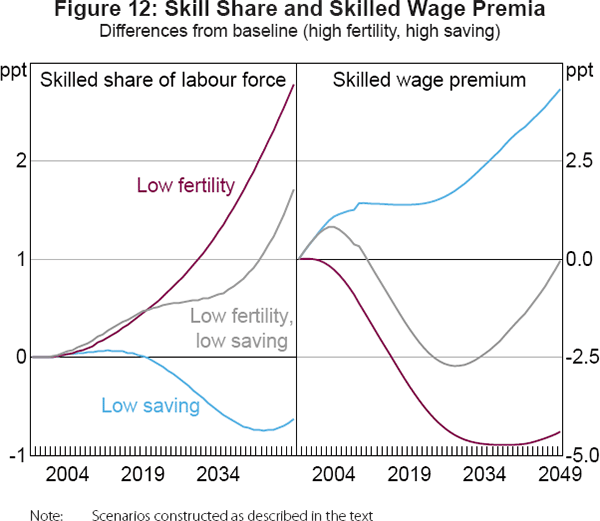
5.2 Saving and economic rebalancing
The extent of rebalancing in the economy is more affected by changes in the savings scenarios than changes in fertility (Figures 13 and 14). The low-saving scenarios show more dramatic declines in saving by construction and are therefore expected to yield more substantial short-run rises in consumption and in the consumption share of GDP. In turn, these lead to shifts in the current account toward deficit. The simulated patterns prove a little more complex than this, however, because consumption behaviour depends on real per capita income. In particular, the low-saving scenario results in a very substantial short-run rise in consumption and in the consumption share of GDP, as consumption spending rises relative to the baseline in the early years but falls subsequently as GDP grows more slowly (Figure 13) and incomes (linked to GNP) grow more slowly still (Figure 9). This result stems from two opposing forces. A falling saving rate advances consumption but the resulting decline in real per capita income retards it, with the latter force coming to dominate around 2040.
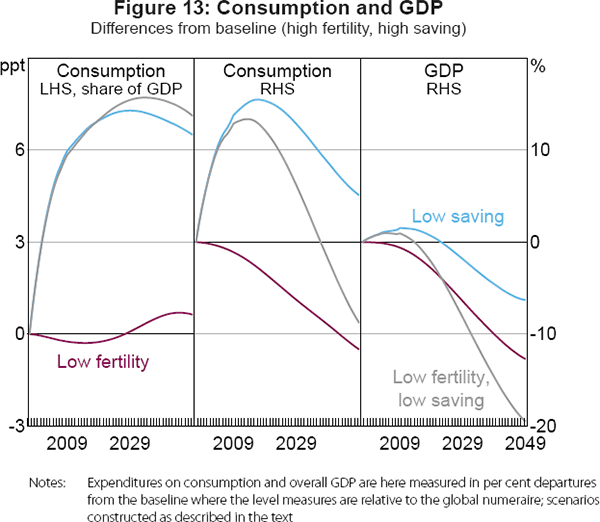
Now consider the low-fertility scenario. The overall saving rates are initially higher in the low-fertility scenario than in the baseline, since expenditure shifts away from children, who do not save, toward retirees, who save less than other adults but more than children.[14] However, throughout the projection period, the influence of the low-saving aged rises and the overall saving rate begins to fall. The net effect in the early decades is a slight fall in the consumption share of GDP (relative to the baseline) that reverses in the later years.
In terms of external rebalancing, the low-saving scenario sees a substantial shift toward current account deficit, ultimately by 14 percentage points of GDP (Figure 14). These changes under the low-saving scenario effectively reverse the imbalance that has been the primary international concern since the 1990s. They have the effect of tightening global financial markets and contracting global investment, as suggested by the higher yields under these scenarios for China and abroad (Figure 15).
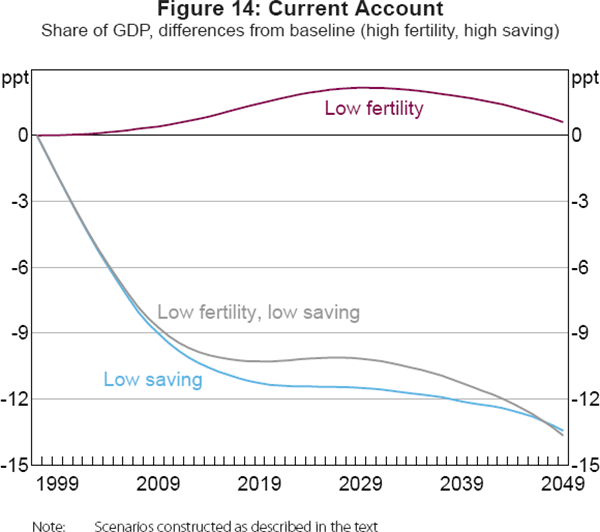
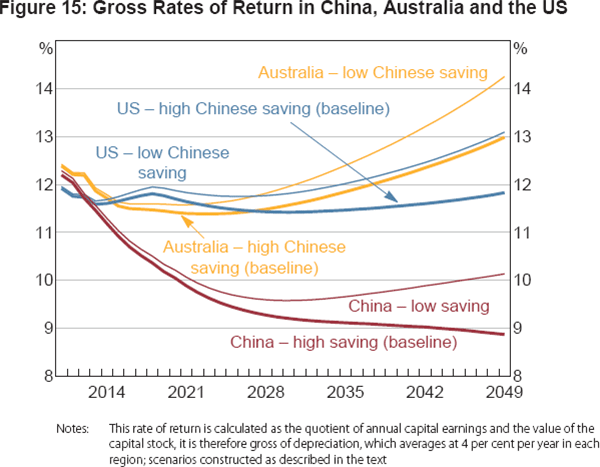
5.3 Sectoral implications
Relative to the baseline, the overall contractions in real GDP due to demographic decline and reduced saving are accompanied by contractions in the output generated in all seven of the industries considered. The primary drivers of these changes are reduced endowments of labour and skill for the demographic contraction and reductions in accumulated capital for the low-saving scenario. When these variable factors are reduced relative to the fixed factors, land and natural resources, the relatively advantaged sectors are agriculture and energy (Figure 16). On the other hand, the greatest contractions are in the sectors most intensive in labour and capital, namely metals, minerals and manufactures. As expected, the contractions are larger when fertility decline is coupled with low saving. This is because, while the rate of capital accumulation is reduced with demographic contraction alone, it is much more affected by savings decline.

By comparison with the baseline, the contraction scenarios raise domestic labour and capital costs, tending to boost value added in some industries even while their output volumes contract. The pattern of change in value-added shares is therefore slightly different from those in final output volumes (Figure 17). The value-added shares of manufacturing and services expand, while those of minerals, metals and agriculture contract. Significantly, after 2030, when the demographic contraction is strongest, there is a substantial increase in the share of services. This is a price effect associated with the rising relative costs of labour, skill and capital, the factors on which services exclusively depend. The fact that services cannot easily be substituted with imports causes their product price to rise more than others. Moreover, their comparative intensity in high-skill labour tends to raise the skill premium.
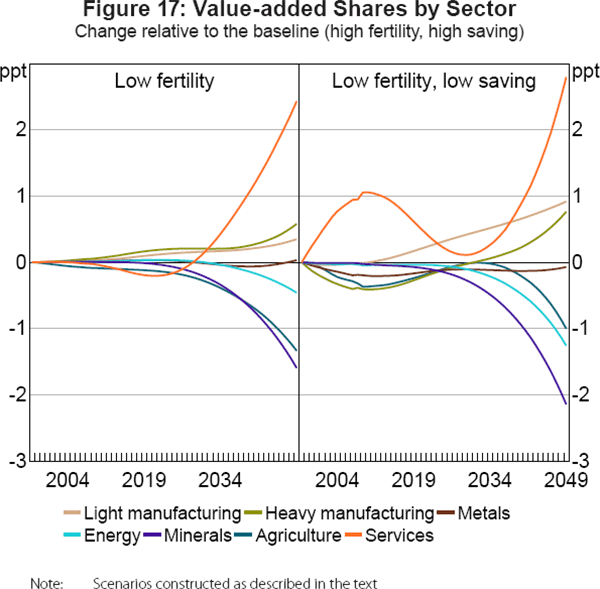
6. The View from Abroad
The effects of lower Chinese fertility and saving on foreign regions are transmitted through finance and trade. While demographic change alone has modest effects on global financial markets, reduced Chinese saving tightens them substantially. By 2050, the extent of financial tightening varies across regions but is approximately 130 basis points per annum in China, the United States and Australia. This reflects the loss of Chinese saving that finances new investment globally in the baseline scenario. Tighter financial markets and a smaller Chinese labour force turn out to have considerable effects on global growth: in the worst-case scenario of a double contraction, world GDP in 2050 is 9 per cent lower than the baseline, or 7 per cent lower if China is excluded (Figure 18).
Clearly, by 2050, China's economic performance will be very significant for global welfare. The distribution of effects on other regions depends on the level of China's financial integration and on the direction and composition of its trade flows. The model assumes a high level of financial integration and little financial discrimination across regions.[15] It retains considerable momentum in the direction of trade flows, however, and so Chinese shocks might be expected to significantly affect regional welfare via idiosyncratic changes in real exchange rates and the terms of trade. The product-specific effects are discussed in the next sub-section. Before doing so, however, it is useful to consider changes in real exchange rates.
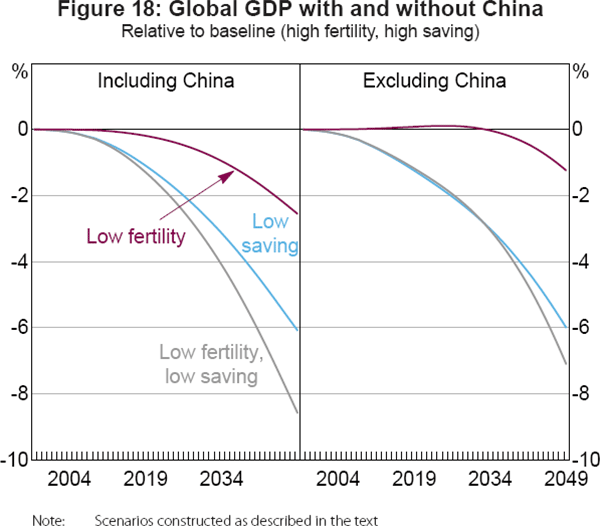
Real exchange rates are modelled bilaterally against the US dollar, calculated as the ratio of the regional GDP price with that of the United States. These bilateral rates are then combined with trade shares to calculate trade-weighted indices, or real effective exchange rates for each region. For China, regional shocks contracting essential factors of production, like labour and physical capital, tend to raise comparative costs and therefore appreciate the region's real effective exchange rate (Figure 19).[16] In smaller regions that depend on exports to China, such as Australia, the Chinese contractions reduce global demand for their products and so lower their prices relative to the products of other regions. Thus, they cause real depreciations.[17]
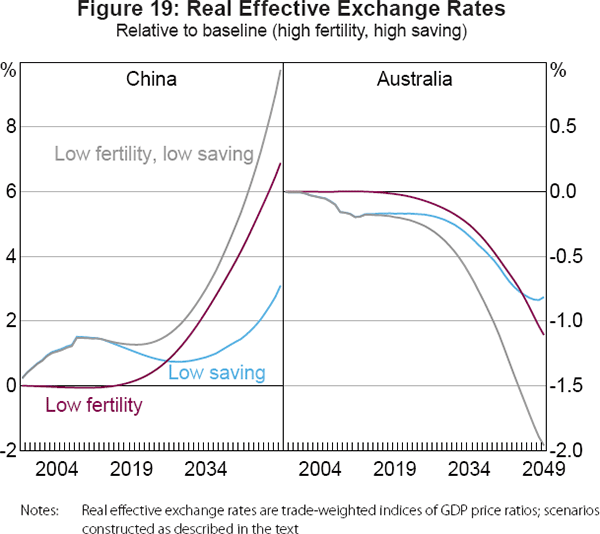
6.1 Effects on the volume and composition of China's exports and imports
China's total trade, unsurprisingly, takes a lower growth path under the low-saving and low-fertility scenarios relative to the baseline. Its variable factors of production shrink and, at least in the short run, low-saving scenarios raise home consumption expenditure, which can be expected to reduce exports and boost imports. In the long run, slower population growth and more rapid savings decline reduce Chinese economic activity, and so trade flows also take a slower path (Figure 20). Of particular interest abroad, however, are the product compositions of China's import and export values (Table 2).
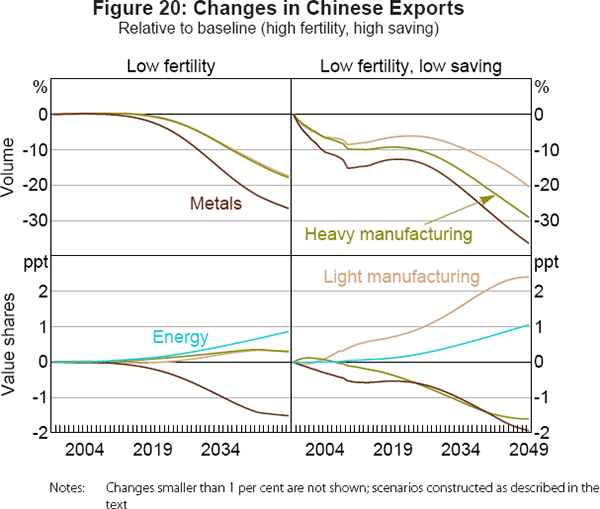
| Baseline | Alternative scenarios – 2050 | |||
|---|---|---|---|---|
| 2015 | 2050 | Low fertility, high saving |
Low fertility, low saving |
|
| Agriculture | 0.1 | 0.1 | 0.1 | 0.1 |
| Light manufacturing | 29.9 | 26.6 | 26.9 | 29.0 |
| Heavy manufacturing | 54.7 | 56.0 | 56.3 | 54.4 |
| Metals | 11.2 | 15.0 | 13.5 | 13.0 |
| Energy | 1.6 | 1.3 | 2.1 | 2.3 |
| Minerals | 0.3 | 0.1 | 0.0 | 0.0 |
| Services | 2.2 | 1.0 | 1.1 | 1.1 |
| Total | 100.0 | 100.0 | 100.0 | 100.0 |
|
Notes: Data for 2015 are as simulated, with calibrated intermediate shocks, from a 1998 database; scenarios constructed as described in the text |
||||
It is understandable that, in the baseline case, the rise of the skilled labour force, combined with continued rapid capital accumulation, should see expanded exports of heavy manufactures. While these come to dominate China's trade, exports of metals assume a significant role. This is a figment of the exogenous productivity shocks embodied in the baseline, from which most of our analysis is independent. In this instance, however, the rise of metals exports does affect both the initial export shares and the changes that take place in them. This characterisation reflects the experience of both Japan and South Korea, which became exporters of processed metals as the growth in their domestic use subsided.
More broadly, the shares might be expected to respond to changes in China's pattern of comparative advantage, due to the new trajectories of its factor endowments and its real exchange rate. While the simulated pattern is consistent with these underlying forces, the actual departures from the baseline are surprisingly small. The low-fertility scenario has the shares of total exports devoted to energy and manufactures expanding relative to the baseline, while the metals export share contracts. When the savings contraction is added, the effects are larger, with the baseline trend toward heavy manufacturing exports reversed in favour of a return to dependence on light manufacturing exports. Again, the share of metal exports falls and that of energy exports expands.
On the import side there is considerable diversity in outcomes relative to the baseline (Figure 21). Most conspicuous is the short-run increase in imports that results from higher consumption expenditure in the low-saving scenario. Beyond 2020, however, the effect of slower capital accumulation and labour force growth on domestic income comes to dominate and imports contract relative to the baseline. The changes in import composition turn out to be more robust to the type of shock delivered. Relative to the baseline, whether the scenario is slower population or slower saving growth, the share of imported minerals rises while the shares of energy and agricultural products contract. Metal exports constitute 15 per cent of export revenue in the baseline, suggesting that China will follow Japan and South Korea in becoming an exporter of steel and other metal products. With contracting population and savings, metal production contracts relative to the baseline and metal exports contract in share. But the relative decline in overall imports sees the share of this eventually export-oriented industry's mineral inputs expand.

6.2 Changes in international prices and real per capita income abroad
These changes in China's trade lead to corresponding changes in international trading prices and hence in the terms of trade faced by other regions (Figure 22). For the products that dominate world trade, namely manufactures, the changes due to China's low fertility and low saving are small. But the effects are very large for agriculture and energy products, most particularly in response to slower Chinese saving growth. The results suggest that a slowing Chinese economy will continue to have a significant negative effect on energy markets.
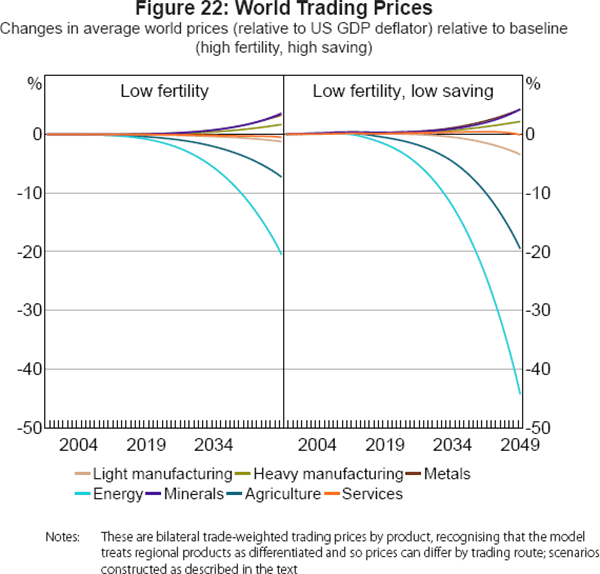
Because the model characterises products as being differentiated by region of origin, international prices differ by trading route. This recognises that the composition of product groups in exports differ across trading routes. In Australia's case, energy exports are projected to continue through 2050, but implicit in the behaviour embodied is that those energy exports are dominated by coal. A demographic contraction alone affects Australia's export prices less than the global average, but when a savings reduction is added Australia's energy exports are more affected than the others and so Australia's energy export price falls by more than the global average, relative to the baseline (Figure 23). Quite clearly, Australia is little affected by a Chinese demographic contraction alone but it is affected very substantially by a decline in China's savings and hence in the capital intensity of its future growth and its products.
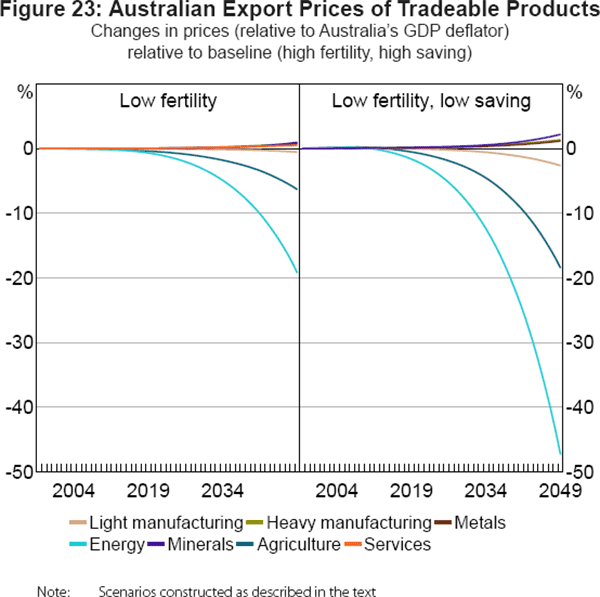
Perhaps the best bottom line measure of the international welfare effects of low Chinese fertility and saving is the change in regional real per capita income (Figure 24).[18] Two regions stand out as being most affected by the Chinese slowdown. The first is India, which benefits, especially from the demographic contraction. It is the alternative large and populous economy and, as modelled at least, its low real wages, comparatively rapid population growth and rising share of workers in the population leave it poised to take over the industrial path of China.[19] The comparative slowness of its economic policy reforms and the bias against manufacturing that is embodied in its labour laws are not accounted for in this analysis. Thus, the simulations suggest that slower Chinese growth benefits India by making energy and food cheaper and by creating room for a growing Indian manufacturing industry. At the other end of the spectrum is the composite region, Russia and eastern Europe. As a large energy exporter this region suffers a substantial decline in its terms of trade, particularly when there is both a demographic and a savings contraction in China.
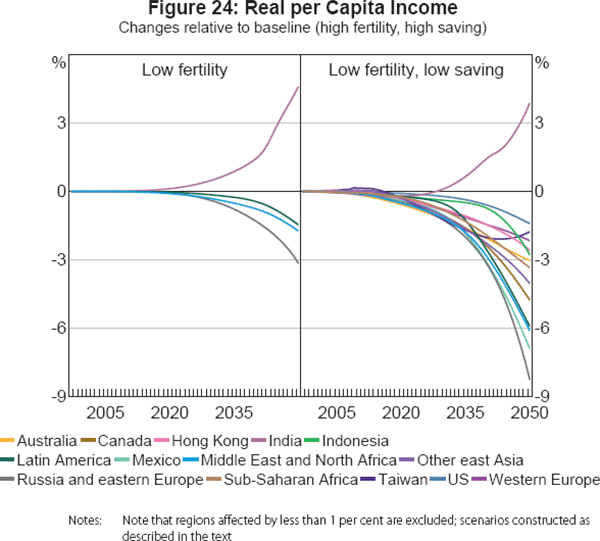
Most other regions are also net losers from the loss of Chinese economic activity, though mainly from the loss of Chinese savings and therefore the higher cost of capital each must bear. (Table 3). In Australia's case, the net effect of the deterioration in the financial terms of trade in the low-saving scenario combines with a marginally negative product terms of trade change. A stronger negative terms of trade effect is avoided by the significantly lower Chinese manufactured export prices and the comparative stability of Chinese mineral import volumes, at least as modelled.
| Low fertility, high saving |
High fertility, low saving |
Low fertility, low saving |
|
|---|---|---|---|
| Australia | −0.1 | −2.9 | −3.0 |
| United States | −0.3 | −1.1 | −1.4 |
| Canada | −1.5 | −3.5 | −4.8 |
| Mexico | −0.8 | −6.2 | −6.9 |
| Western Europe | −0.9 | −1.4 | −2.2 |
| Russia and eastern Europe | −3.2 | −5.2 | −8.3 |
| Japan | −1.0 | 0.8 | −0.4 |
| China | 20.7 | −15.4 | −2.7 |
| Taiwan | −0.7 | −1.0 | −1.8 |
| Hong Kong | −1.3 | −1.4 | −2.6 |
| Indonesia | −0.1 | −2.9 | −2.8 |
| Other east Asia | −0.6 | −3.6 | −4.0 |
| India | 4.6 | −0.3 | 3.9 |
| Other south Asia | 0.8 | −1.6 | −0.8 |
| Latin America | −1.5 | −4.7 | −5.9 |
| Middle East and north Africa | −1.7 | −4.7 | −6.1 |
| Sub-Saharan Africa | −0.9 | −2.7 | −3.3 |
| Rest of world | −1.6 | −3.2 | −4.7 |
|
Note: Scenarios constructed as described in the text |
|||
7. Conclusions
This paper sets out to assess the importance, both within China and abroad, of a number of conundrums facing Chinese leaders as they embark on a new phase of development in which slower GDP growth is being portrayed as the ‘new normal’. Using a dynamic global economic model with full demographic behaviour to project through to 2050, a quantitative perspective is offered for many, if not all, of the complex linkages between China's demographic change, saving rates and economic performance. The results support the following points.
First, fertility levels rising toward population sustainability levels would indeed contribute to higher rates of GDP growth, an increase in the proportion of children and a reduction in the proportion of aged people in China in the decades ahead, as well as providing a modest source of higher domestic consumption. Our analysis confirms that these effects would be small – amounting to less than half a per cent per year of GDP growth and a reduction in aged dependency by 0.03 percentage points. Furthermore, higher fertility would come at a significant cost in terms of per capita GDP, reducing its level by 21 per cent in 2050 compared with the low-fertility scenario.
Second, we consider the case in which fertility rises toward population sustainability levels but there is more rapid savings decline, induced by a range of policy reforms. We think of this as the ‘dual policy success’ scenario. It would result in a rebalancing of the domestic economy towards consumption, while shifting China's external balance away from surplus and toward deficit. Yet, the associated decline in China's rate of capital accumulation and a relative increase in foreign ownership of home capital would see this coming at a significant cost to China's future income. Indeed, its real household income per capita would be 15 per cent lower than the baseline scenario by 2050. This reduction in per capita income would translate into lower consumption in the longer term, with the slowdown being substantial enough to bring about a fall in consumption as a percentage of GDP from around 2035. Moreover, the lower growth path of real per capita income resulting from both lower savings and higher fertility would cause the high-skill share of the labour force to decline relative to the other scenarios, impeding China's ongoing efforts to upgrade its industrial structure.
Third, the final scenario considered has declines in both fertility and saving rates, according most accurately with our expectations, notwithstanding considerable uncertainty about both. We refer to this as the ‘double contraction’ scenario and it is the one where the implications for the global economy prove to be most apparent. Not surprisingly, it yields slower population and labour force growth and a significantly lower growth path for all Chinese economic activity. While the boost to China's domestic consumption from lower savings is shown to boost imports in the short term, beyond 2020 this outcome is reversed in all but minerals, which, as modelled, feeds a domestic metals industry that becomes export oriented following the experience of South Korea.
Finally, our results do not imply that we do not support the Chinese Government's decision to abolish the one-child policy: the non-economic benefits of this shift are, quite simply, immeasurable. Rather, they call for recognition that a two-child policy – were the people to respond to it – is not a first-best policy option for tackling either China's growth slowdown or its ageing problem. The fact that the bulk of recent demographic research indicates that China's fertility rates will not, in fact, rise to the levels implied by our baseline adds further weight to this call. Likewise, our results do not imply that rebalancing the Chinese economy is necessarily a bad idea. Rather, this paper highlights the need for alternative sources of growth if China is to fend off the negative outcomes that its current ‘dual policy objective’ implies. Raising the productivity of all factors of production (labour, land, capital and natural resources) and speeding up the pace of skill transformation (or human capital acquisition) seem like the obvious places to look for replacing the physical capital accumulation that has been the dominant driver of growth in the past, and that will inevitably decline in the future. Increasing labour force participation rates – by simple measures such as raising the statutory retirement age (planned for 2017), and by more complex reforms to the welfare and hukou systems – would directly tackle China's ageing problem and provide an additional source of growth as well (Golley and Tyers, 2012a, 2012b). Exploring the positive effects that these could have on both the Chinese and global economies remains the task of another paper.
Footnotes
Useful discussions on the topic with Ligang Song, Yanrui Wu and Warwick McKibbin are acknowledged, along with comments received on related research at seminars at the Australian National University and the Hong Kong Institute for Monetary Research. Particular thanks are due to Leon Berkelmans, discussant, and to other commentators at the annual conference of the Reserve Bank of Australia, 16–17 March 2016. [*]
International consequences are surveyed by Tyers (2015, 2016). [1]
The demographic dividend is well researched, including by Cai and Wang (2005), Bloom et al (2010), Wei and Hao (2010) and Golley and Tyers (2012a). [2]
See Golley and Tyers (2012b) for a more detailed discussion on this point, about which most, but not all, economists agree. See also Solow (1956) and Swan (1956), and the detailed analytical review of offered by Pitchford (1974, ch 4). [3]
See Bloom and Williamson (1998) for a generic discussion of the demographic dividend in developing countries, Bloom et al (2010) for a detailed examination of the implications for Asia, and Cai and Wang (2005) for implications for China. [4]
For example, Modigliani and Cao (2004) (not surprisingly) find empirical support for it; Chamon and Prasad (2008) find an ‘unusual U-shape’, with high saving rates in the younger workers and older cohorts; and Horioka and Wan (2007) find that demographic variables have little impact on Chinese saving rates, arguing that high saving rates are likely to persist in China for some time, despite rapid ageing. [5]
There is evidence that the rise in the consumption share of GDP began earlier than the official statistics suggest. See Garner and Qiao (2013) and Huang, Chang and Yang (2013). [6]
See, for example, the literature asserting and depending on the ‘savings glut’ hypothesis, cited in the introduction and Arora, Tyers and Zhang (2015). The American literature critical of China's macroeconomic policies is also extensive. Bernanke (2005, 2011) offers the outline and Krugman (2010) declares that ‘China is making all of us poorer’. The US macroeconomic position is put in more detail by, amongst others, Lardy (2006, 2012) and Bergsten et al (2008). Similar advocacy of policy-induced ‘imbalance’ in China's growth can be found, still more formally, in Blanchard and Giavazzi (2006). [7]
The GTAP-Dynamic model is a development of its comparative static progenitor, GTAP (Hertel 1997). Its dynamics were initially developed by Ianchovichina and McDougall (2000) and presented comprehensively by Ianchovichina and Walmsley (2012). Applications of the standard model with preliminary demography include those by Tyers and Shi (2007, 2012). [8]
As emphasised in World Bank Group (2016), while migration surges during periods of conflict, flows through time are overwhelmingly motivated by differences in real per capita income and real wages. [9]
For a model in which human capital accumulation plays a larger role, see Harris and Robertson (2013). [10]
In particular, agricultural productivity grows more rapidly than that in the other sectors in China, along with Australia, Indonesia, other east Asia, India and other south Asia. This is due to continued increases in labour productivity in agriculture and the associated shedding of labour to other sectors. In the other industrialised regions, the process of labour relocation has slowed down and labour productivity growth is slower in agriculture. In the other developing regions, the relocation of workers from agriculture has tended not to be so rapid. For China, these shocks are informed by such surveys as that by Wu (2011). [11]
Our long-run analysis does not address short-run policy reform priorities that include financial reform and internationalisation of the currency (He et al 2012). [12]
This point is discussed at length in Golley and Tyers (2012a, 2012b). [13]
As described in Section 4.3, the assumed levels of saving for each age group are the same in the baseline and the low-fertility, highsaving scenario, but the aggregate saving rate is different because of the difference in the age structure of the population. [14]
This is a consequence of the characterisation of international capital flows as via an intermediary ‘global trust’, which receives investment, rewards it at a globally common rate and distributes it across destination regions according to rates of return. A full bilateral representation of financial flows is being developed. [15]
For comprehensive surveys of the determinants of China's real and nominal exchange rates, see Tyers and Zhang (2011, 2014). [16]
The historical effects of China's pre-global financial crisis growth surge on Australia's real effective exchange rate were larger than indicated in Figure 19. The model used here is long run in orientation (physical capital is mobile between industries) and so it under-represents the very sharp spikes in commodity prices in this period. [17]
Real per capita income is defined conventionally as household income divided by the population and deflated by the consumer price index, all of which are carried by the model. [18]
For details on India's pending demographic dividend, see the comparative analysis with China by Golley and Tyers (2012a, 2012b). [19]
References
Arora V, R Tyers and Y Zhang (2015), ‘Reconstructing the Savings Glut: The Global Implications of Asian Excess Saving’, International Journal of Economics and Finance, 7(7), pp 19–42.
Basten S and Q Jiang (2015), ‘Fertility in China: An Uncertain Future’, Population Studies, 69(S1), pp S97–S105.
Bergsten CF, C Freeman, NR Lardy and DJ Mitchell (2008), China's Rise: Challenges and Opportunities, Peterson Institute for International Economics, Washington DC.
Bernanke BS (2005), ‘The Global Saving Glut and the U.S. Current Account Deficit’, Sandridge Lecture, Virginia Association of Economists, Richmond, 10 March.
Bernanke BS (2011), ‘Global Imbalances: Links to Economic and Financial Stability’, Speech given at the Banque de France Financial Stability Review Launch Event, Paris, 18 February.
Blanchard O and F Giavazzi (2006), ‘Rebalancing Growth in China: A Three-Handed Approach’, China & World Economy, 14(4), pp 1–20.
Bloom DE, D Canning, L Hu, Y Liu, A Mahal and W Yip (2010), ‘The Contribution of Population Health and Demographic Change to Economic Growth in China and India’, Journal of Comparative Economics, 38(1), pp 17–33.
Bloom DE and JG Williamson (1998), ‘Demographic Transitions and Economic Miracles in Emerging Asia’, The World Bank Economic Review, 12(3), pp 419–455.
Cai F (2010), ‘Demographic Transition, Demographic Dividend, and Lewis Turning Point in China’, China Economic Journal, 3(2), pp 107–119.
Cai F (2012), ‘The Coming Demographic Impact on China's Growth: The Age Factor in the Middle-Income Trap’, Asian Economic Papers, 11(1), pp 95–111.
Cai F and D Wang (2005), ‘Demographic Transition: Implications for Growth’, in R Garnaut and L Song (eds), The China Boom and its Discontents, ANU E Press and Asia Pacific Press, Canberra, pp 34–52.
Chamon M and E Prasad (2008), ‘Why are Saving Rates of Urban Households in China Rising?’, IMF Working Paper No WP/08/145.
Chen J, RD Retherford, MK Choe, L Xiru and H Ying (2009), ‘Province-Level Variation in the Achievement of Below-Replacement Fertility in China’, Asian Population Studies, 5(3), pp 309–328.
Choukhamane T, N Coeurdacier and K Jin (2014), ‘The One-Child Policy and Household Savings’, Unpublished manuscript, 18 September.
Dixon PB and MT Rimmer (2002), Dynamic General Equilibrium Modelling for Forecasting and Policy: A Practical Guide and Documentation of MONASH, Contributions to Economic Analysis, 256, Emerald Group Publishing Limited, Bingley.
Du Q and S-J Wei (2010), ‘Sex Ratios, Savings Rates, and Current Account Imbalances’, Unpublished manuscript, Columbia University, 6 December.
Du Q and S-J Wei (2012), ‘A Darwinian Perspective on “Exchange Rate Undervaluation”’, NBER Working Paper No 16788, rev February 2012.
Feng W and Y Cai (2010), ‘China's One Child Policy at 30’, Brookings Institution Research and Commentary, 24 September, viewed 5 May 2015. Available at <http://www.brookings.edu/research/opinions/2010/09/24-china-one-child-policy-wang>.
Feng W, Y Cai and B Gu (2012), ‘Population, Policy, and Politics: How Will History Judge China's One-Child Policy?’, Population and Development Review, 38 (Supplement s1), pp 115–129.
Garner J and H Qiao (2013), ‘Chinese Household Consumption – Most Likely US$1.6trn Larger than Officially Stated’, Morgan Stanley Research, Asia Insight, 28 February, p 3.
Golley J and X Meng (2011), ‘Has China Run Out of Surplus Labour?’, China Economic Review, 22(4), pp 555–572.
Golley J and R Tyers (2012a), ‘Demographic Dividends, Dependencies, and Economic Growth in China and
Golley J and R Tyers (2012b), ‘Population Pessimism and Economic Optimism in the Asian Giants’, The World Economy, 35(11), pp 1387–1416.
Golley J and R Tyers (2014), ‘Gender “Rebalancing” in China’, Asian Population Studies, 10(2), pp 125–143.
Golley J and AZ Wei (2013), ‘China's Rural-Urban Age Structure, Sectoral Employment and Economic Growth’, Crawford School Working Paper No 13–12.
Harris RG and PE Robertson (2013), ‘Trade, Wages and Skill Accumulation in the Emerging Giants’, Journal of International Economics, 89(2), pp 407–421.
He D, L Cheung, W Zhang and T Wu (2012), ‘How Would Capital Account Liberalization Affect China's Capital Flows and Renminbi Real Exchange Rates?’, China & World Economy, 20(6), pp 29–54.
Hertel TW (ed) (1997), Global Trade Analysis: Modeling and Applications, Cambridge University Press, New York.
Horioka CY and J Wan (2007), ‘The Determinants of Household Saving in China: A Dynamic Panel Analysis of Provincial Data’, Federal Reserve Bank of San Francisco Working Paper Series 2007-28.
Hu A, J Zheng, Y Gao, N Zhang and H Xu (2008), ‘考虑环境因素的省级技术效率排名(1999–2005)’ (Provincial Technology Efficiency Ranking with Environment Factors (1999–2005)), ‘<<经济学(季刊)>>’ (China Economic Quarterly), 7(3), pp 933–960.
Huang Y, J Chang and L Yang (2013), ‘Consumption Recovery and Economic Rebalancing in China’, Asian Economic Papers, 12(1), pp 47–67.
Ianchovichina E and R McDougall (2000), ‘Theoretical Structure of Dynamic GTAP’, GTAP Technical Paper No 17.
Ianchovichina E and TL Walmsley (eds) (2012), Dynamic Modeling and Applications for Global Economic Analysis, Cambridge University Press, Cambridge.
Krugman P (2010), ‘Capital Export, Elasticity Pessimism and the Renminbi (Wonkish)’, New York Times, online blog, 16 March, viewed 10 June 2013.
Lardy NR (2006), ‘China: Toward a Consumption-Driven Growth Path’, Peterson Institute for International Economics, Policy Briefs in International Economics No PB06-6.
Lardy NR (2012), Sustaining China's Economic Growth after the Global Financial Crisis, Peterson Institute for International Economics, Washington DC.
Lau LJ, Y Qian and G Roland (2000), ‘Reform without Losers: An Interpretation of China's Dual-Track Approach to Transition’, Journal of Political Economy, 108(1), pp 120–143.
Lewis WA (1954), ‘Economic Development with Unlimited Supplies of Labour’, The Manchester School, 22(2), pp 139–191.
Li K (2015), ‘Report on the Work of the Government’, Xinhuanet.com, 16 March, viewed 20 March 2015. Available at <http://news.xinhuanet.com/english/china/2015-03/16/c_134071473_2.htm>.
Liu JN, N van Leeuwen, TT Vo, R Tyers and TW Hertel (1998), ‘Disaggregating Labor Payments by Skill Level in GTAP’, GTAP Technical Paper No 11.
Ma G and Y Wang (2010), ‘China's High Saving Rate: Myth and Reality’, International Economics, 122, pp 5–39.
Minami R and X Ma (2010), ‘The Lewis Turning Point of Chinese Economy: Comparison with Japanese Experience’, China Economic Journal, 3(2), pp 163–179.
Modigliani F (1966), ‘The Life Cycle Hypotheses of Saving, the Demand for Wealth and the Supply of Capital’, Social Research, 33(2), pp 160–217.
Modigliani F and SL Cao (2004), ‘The Chinese Saving Puzzle and the Life-Cycle Hypothesis’, Journal of Economic Literature, 42(1), pp 145–170.
Naughton B (2014), ‘Is There a “Xi Model” of Economic Reform? Acceleration of Reform since Fall 2014’, China Leadership Monitor, 46, Article 4.
Orlik T, Z Ming, L Kuijs, NR Lardy, C Li, KW Chan, H Yu, L Ping, AA Liu and F Chen (2014), ‘China's Transition: The Third Plenum – One Year On’, Bloomberg Briefs, October, viewed 30 November 2014.
Pitchford JD (1974), Population in Economic Growth, Contributions to Economic Analysis, 85, North Holland Publishing Company, Amsterdam.
Solow RM (1956), ‘A Contribution to the Theory of Economic Growth’, The Quarterly Journal of Economics, 70(1), pp 65–94.
Swan TW (1956), ‘Economic Growth and Capital Accumulation’, Economic Record, 32(2), pp 334–361.
Tyers R (2015), ‘International Effects of China's Rise and Transition: Neoclassical and Keynesian Perspectives’, Journal of Asian Economics, 37, pp 1–19.
Tyers R (2016), ‘Slower Growth and Vulnerability to Recession: Updating China's Global Impact’, Scottish Journal of Political Economy, 63(1), pp 66–88.
Tyers R and I Bain (2015), ‘The Global Economic Implications of Freer Skilled Migration’, The University of Western Australia, Economics Discussion Paper No 15.12.
Tyers R and Q Shi (2007), ‘Demographic Change and Policy Responses: Implications for the Global Economy’; The World Economy, 30(4), pp 537–566.
Tyers R and Q Shi (2012), ‘Global Demographic Change, Labor Force Growth, and Economic Performance’, in E Ianchovichina and TL Walmsley (eds), Dynamic Modeling and Applications for Global Economic Analysis, Cambridge University Press, Cambridge, pp 342–375.
Tyers R and Y Zhang (2011), ‘Appreciating the Renminbi’, The World Economy, 34(2), pp 265–297.
Tyers R and Y Zhang (2014), ‘Real Exchange Rate Determination and the China Puzzle’, Asian-Pacific Economic Literature, 28(2), pp 1–32.
United Nations (2015), World Population Prospects: The 2015 Revision, UN Population Division.
Wang M and F Cai (2015), ‘Destination Consumption: Enabling Migrant's Propensity to Consume’, in L Song, R Garnaut, F Cai and L Johnston (eds), China's Domestic Transformation in a Global Context, China Update, ANU Press, Acton, pp 91–110.
Wang X (2015), ‘Two-Child Policy Expected to be Approved by Top Legislature’, ChinaDaily.com.cn, viewed 2 January 2016. Available at <http://www.chinadaily.com.cn/china/2015-12/21/content_22759611.htm>.
Wei Z and R Hao (2010), ‘Demographic Structure and Economic Growth: Evidence from China’, Journal of Comparative Economics, 38(4), pp 472–491.
World Bank (2013), Capital for the Future: Saving and Investment in an Interdependent World, Global Development Horizons, World Bank, Washington DC.
World Bank Group (2016), Development Goals in an Era of Demographic Change, Global Monitoring Report 2015/2016, The World Bank, Washington DC.
Wu HX (2014), ‘China's Growth and Productivity Performance Debate Revisited – Accounting for China's Sources of Growth with a New Data Set’, The Conference Board Economics Program Working Paper Series EPWP #14 – 01.
Wu Y (2011), ‘Total Factor Productivity Growth in China: A Review’, Journal of Chinese Economic and Business Studies, 9(2), pp 111–126.
Xinhua News Agency (2007), ‘Premier: China Confident in Maintaining Economic Growth’, 16 March, viewed February 2016. Available at: <http://news.xinhuanet.com/english/2007-03/16/content_5856569.htm>.
Yang DT, J Zhang and S Zhou (2011), ‘Why are Saving Rates so High in China?’, Institute for the Study of Labor, IZA Discussion Paper No 5465.
Zhao Z (2015), ‘Closing a Sociodemographic Chapter of Chinese History’, Population and Development Review, 41(4), pp 681–686.
